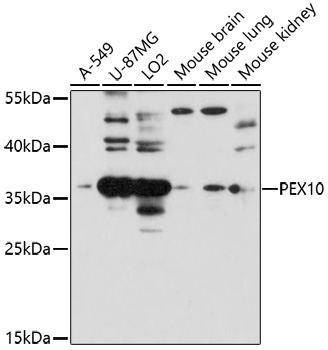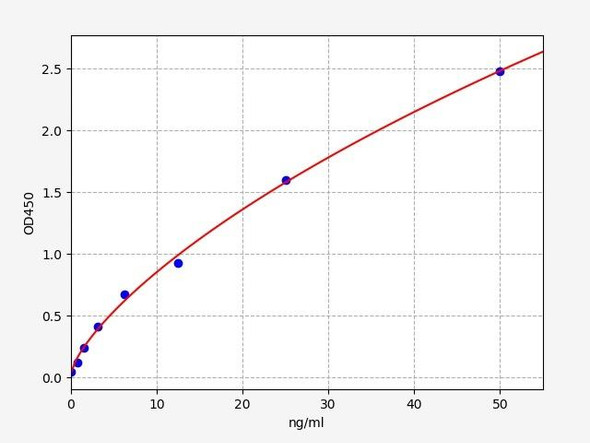Metabolism Antibodies 2
Anti-PEX10 Antibody (CAB16949)
- SKU:
- CAB16949
- Product Type:
- Antibody
- Reactivity:
- Human
- Reactivity:
- Mouse
- Host Species:
- Rabbit
- Isotype:
- IgG
- Antibody Type:
- Polyclonal Antibody
- Research Area:
- Metabolism
Description
| Antibody Name: | Anti-PEX10 Antibody |
| Antibody SKU: | CAB16949 |
| Antibody Size: | 20uL, 50uL, 100uL |
| Application: | WB |
| Reactivity: | Human, Mouse |
| Host Species: | Rabbit |
| Immunogen: | Recombinant fusion protein containing a sequence corresponding to amino acids 10-160 of human PEX10 (NP_002608.1). |
| Application: | WB |
| Recommended Dilution: | WB 1:500 - 1:2000 |
| Reactivity: | Human, Mouse |
| Positive Samples: |
| Immunogen: | Recombinant fusion protein containing a sequence corresponding to amino acids 10-160 of human PEX10 (NP_002608.1). |
| Purification Method: | Affinity purification |
| Storage Buffer: | Store at -20'C. Avoid freeze / thaw cycles. Buffer: PBS with 0.02% sodium azide, 50% glycerol, pH7.3. |
| Isotype: | IgG |
| Sequence: | EVIR AAQK DEYY RGGL RSAA GGAL HSLA GARK WLEW RKEV ELLS DVAY FGLT TLAG YQTL GEEY VSII QVDP SRIH VPSS LRRG VLVT LHAV LPYL LDKA LLPL EQEL QADP DSGR PLQG SLGP GGRG CSGA RRWM RHHT ATLT EQQR RAL |
| Gene ID: | 5192 |
| Uniprot: | O60683 |
| Cellular Location: | |
| Calculated MW: | |
| Observed MW: | Refer to figures |
| Synonyms: | PEX10, NALD, PBD6A, PBD6B, RNF69 |
| Background: | This gene encodes a protein involved in import of peroxisomal matrix proteins. This protein localizes to the peroxisomal membrane. Mutations in this gene result in phenotypes within the Zellweger spectrum of peroxisomal biogenesis disorders, ranging from neonatal adrenoleukodystrophy to Zellweger syndrome. Alternative splicing results in two transcript variants encoding different isoforms. |
| UniProt Protein Function: | PEX10: Somewhat implicated in the biogenesis of peroxisomes. Defects in PEX10 are the cause of peroxisome biogenesis disorder complementation group 7 (PBD-CG7); also known as PBD-CGB. PBD refers to a group of peroxisomal disorders arising from a failure of protein import into the peroxisomal membrane or matrix. The PBD group is comprised of four disorders: Zellweger syndrome (ZWS), neonatal adrenoleukodystrophy (NALD), infantile Refsum disease (IRD), and classical rhizomelic chondrodysplasia punctata (RCDP). ZWS, NALD and IRD are distinct from RCDP and constitute a clinical continuum of overlapping phenotypes known as the Zellweger spectrum. The PBD group is genetically heterogeneous with at least 14 distinct genetic groups as concluded from complementation studies. Defects in PEX10 are a cause of Zellweger syndrome (ZWS). ZWS is a fatal peroxisome biogenesis disorder characterized by dysmorphic facial features, hepatomegaly, ocular abnormalities, renal cysts, hearing impairment, profound psychomotor retardation, severe hypotonia and neonatal seizures. Death occurs within the first year of life. Defects in PEX10 are a cause of adrenoleukodystrophy neonatal (NALD). NALD is a peroxisome biogenesis disorder (PBD) characterized by the accumulation of very long- chain fatty acids, adrenal insufficiency and mental retardation. Belongs to the pex2/pex10/pex12 family. 2 isoforms of the human protein are produced by alternative splicing. |
| UniProt Protein Details: | Protein type:Ubiquitin conjugating system; Ubiquitin ligase; Ligase; EC 6.3.2.- Chromosomal Location of Human Ortholog: 1p36.32 Cellular Component: integral to peroxisomal membrane; intracellular; peroxisomal membrane; peroxisome Molecular Function:protein binding; protein C-terminus binding; zinc ion binding Biological Process: peroxisome organization and biogenesis; protein import into peroxisome matrix Disease: Peroxisome Biogenesis Disorder 6a (zellweger); Peroxisome Biogenesis Disorder 6b |
| NCBI Summary: | This gene encodes a protein involved in import of peroxisomal matrix proteins. This protein localizes to the peroxisomal membrane. Mutations in this gene result in phenotypes within the Zellweger spectrum of peroxisomal biogenesis disorders, ranging from neonatal adrenoleukodystrophy to Zellweger syndrome. Alternative splicing results in two transcript variants encoding different isoforms. [provided by RefSeq, Jul 2008] |
| UniProt Code: | O60683 |
| NCBI GenInfo Identifier: | 3914299 |
| NCBI Gene ID: | 5192 |
| NCBI Accession: | O60683.1 |
| UniProt Secondary Accession: | O60683,Q5T095, Q9BW90, B3KWD8, |
| UniProt Related Accession: | O60683 |
| Molecular Weight: | 39,214 Da |
| NCBI Full Name: | Peroxisome biogenesis factor 10 |
| NCBI Synonym Full Names: | peroxisomal biogenesis factor 10 |
| NCBI Official Symbol: | PEX10 |
| NCBI Official Synonym Symbols: | NALD; PBD6A; PBD6B; RNF69 |
| NCBI Protein Information: | peroxisome biogenesis factor 10 |
| UniProt Protein Name: | Peroxisome biogenesis factor 10 |
| UniProt Synonym Protein Names: | Peroxin-10; Peroxisomal biogenesis factor 10; Peroxisome assembly protein 10; RING finger protein 69 |
| Protein Family: | Peroxisome biogenesis factor |
| UniProt Gene Name: | PEX10 |
| UniProt Entry Name: | PEX10_HUMAN |
View AllClose







